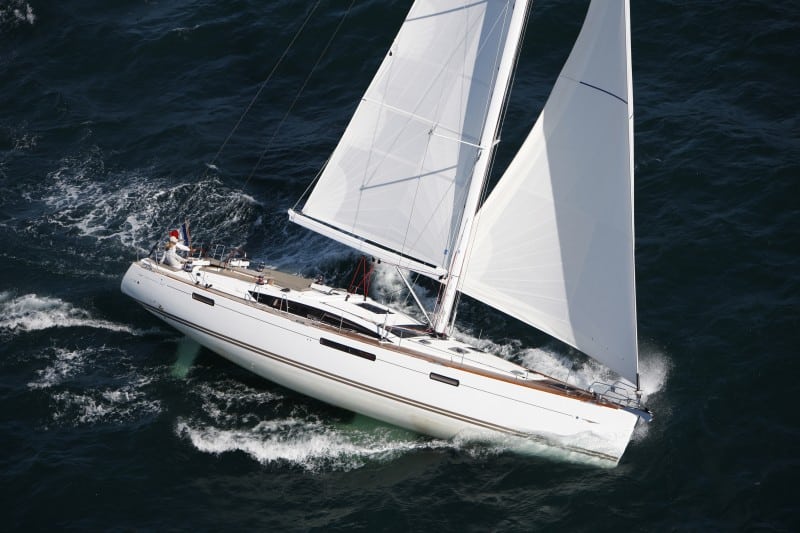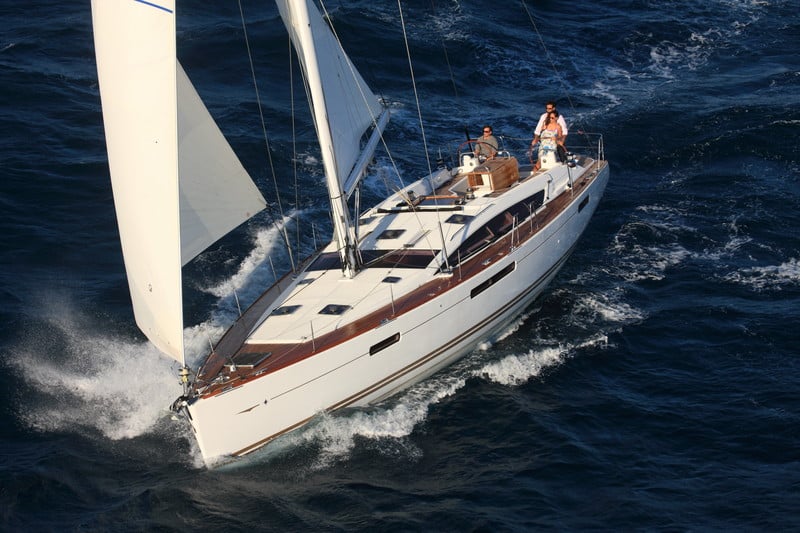
As I glanced over at Henry Ford’s summer house on the tony shores of Grosse Point, Michigan, I couldn’t help but contemplate mass production. Of course, the new line of Jeanneau “Yachts,” comprised of the Jeanneau 53, which I was test-sailing, and an equally well-appointed 57-footer, have little in common with a Model T, except that they’re built on a production line.
And that’s what makes these boats so interesting. They have the good looks, waterline length, interior space, big-boat systems, and bluewater capability often found on custom and semicustom boats in the north-of-50-
feet range, but they’re designed and built to take advantage of many of the mass-production techniques that Jeanneau has developed to enhance both quality and value on its other models. I took the 53 for a test-drive on Lake Michigan to see for myself.
The first thing I noticed on the 53 is that the coachroof is equipped with Jeanneau’s signature curved windows, but the topsides are also noticeably lower and less bulbous than the popular 54 DS, which these boats are designed to replace at the upper end of the Jeanneau line. It’s a subtle change, and in my view, it works. The lines are sleek and sexy without being radical.
I was also impressed with the overall deck layout. The cockpit is truly large (it should be on a cruising boat this size), the teak-covered decks are classy (ditto), and push buttons are right where you want them, next to big, electric-powered winches. The jib cars are fully adjustable from the cockpit and show that this boat is designed to sail as well as be a pretty home on the water. The dual helms provide excellent visibility and equally excellent access to the large swim platform aft. There’s a stout double anchor roller on the bow, the anchor locker is cavernous, and the recessed windlass has plenty of anchor-pulling horsepower. The windlass can even be controlled from the helm station with a separate remote control. It may sound like an oversimplification to say that the layout of the 57 is similar, only bigger, but it’s not really, except for one notable difference: The 57 is big enough to accommodate a tender in an aft “garage” that the 53 doesn’t have.
The 53’s coachroof may be a bit lower slung than that of the 54DS, but you hardly notice it down below. Headroom is way over 6 feet, and the main saloon makes excellent use of the boat’s considerable interior volume. The C-shaped saloon table has room for up to 8 to sit for dinner, with two stylish chairs like you’d find around your dining room table at home. Opposite, the second settee is long enough to be a sea berth and also has a cleverly designed wine locker/armrest hidden beneath one of the seats.
Several cabin and head configurations are available; the galley is the only constant. The galley’s got ample counter and storage space, two reefer units (one can be run as a freezer), and the requisite microwave oven. Our test model also had a good-size forward-facing nav station, a well-installed electrical panel, and plenty of room in which to mount electronics. The layout of the boat I tested features the master cabin aft and two guest cabins forward.
The master cabin is worthy of the “Yacht” moniker. It has excellent headroom, light, and ventilation despite its location beneath the cockpit. It’s also equipped with a large island bed (it seems a bit too luxurious to simply call it a bunk), plenty of storage in both drawers and hanging lockers, a private head with shower, and a TV mounted on the aft bulkhead to watch as you doze off. I found the two forward cabins to be comfortable and well equipped but rather pedestrian. In the sleeping quarters, the master cabin aft seems to have received the most attention.
Both the 53 and 57 use the same varnished Alpi teak-veneer furniture modules, so there’s quite a bit of similarity there. The 57 provides another cabinet, or a bit more elbowroom in spots where there’s more interior space with which to work. The fact that these two boats use similar furniture elements is a prime example of how Jeanneau has exploited production-line efficiencies to trim cost. Sure, there aren’t as many wood or layout choices as you’ll find on a custom boat, but if you like what you see, does it really matter?

Under sail, I was surprised to see how the 53, a 33,000-pound cruising boat that was equipped with an in-mast furling main and 135-percent genoa, performed in 8 to 10 knots of wind. With the sails slightly cracked off upwind, we cut a clean wake, and boat speed hovered in the 5.5- to 6-knot range. Not too shabby. I found the steering to be a little stiff, but the boat tracked well and fell into a nice, wide upwind groove. Both helm stations provide solid brace points, and visibility, both of the telltales and to leeward, was excellent. Speed and handling were similar when we reached off. The larger genoa provided a bit more punch than a nonoverlapping headsail would and helped to compensate for the adequate and easy in-mast furling main that’s necessarily smaller than a conventional main. The Philippe Briand-designed hull was easily driven through the water, and the ability to fine-tune jib shape with the adjustable jib cars rewarded minimal effort with good light-air performance.
Under power, it maneuvered like a yacht. The large three-bladed folding prop and powerful bow thruster made backing out of the slip a highly controlled affair. The boat motored easily at 8 to 8.5 knots at 2,500 rpm, and thanks to considerable engine-room insulation, engine noise was nothing more than an unobtrusive hum.
I think Jeanneau is on to something with its new line of yachts. The 53 is spacious, stylish, and sails well. The 57 has even more elbowroom, more sophisticated systems, larger battery capacity, and the dinghy “garage,” but both boats are designed to do the same thing: provide all the luxury of a big boat without the relatively big big-boat price tag. Granted, a well-equipped, circumnavigation-ready 53 will run you about $500,000, but you’ll get a lot of boat for hundreds of thousands of dollars less than you’d pay for some similarly sized custom yachts. And that kind of savings will bolster any cruising kitty.
Specs
Jeanneau 57
LOA 58′ 4″ (17.78 m.)
LWL 50′ 4″ (15.35 m.)
Beam 16′ 4″ (5.00 m.)
Draft (std./opt.) 8′ 2″/6′ 10″ (2.50/2.10 m.)
Sail Area (100%) 1,421 sq. ft. ( 132.00 sq. m.)
Ballast (std./opt.) 13,448/14,330 lb. (6,100/6,500 kg.)
Displacement 45,415 lb. (20,600 kg.)
Ballast/D (std.) .29
D/L (std.) 159
SA/D 17.86
Water 246 gal. (930 l.)
Fuel 115 gal. (435 l.)
Holding 60 gal. (227 l.)
Mast Height 79′ 4″ (24.20 m.)
Engine 140-hp. VW TDI
Designer Philippe Briand Yacht Design
Sailaway Price approximately $750,000
Jeanneau America
(410) 280-9400
www.jeanneauamerica.com
Jeanneau 53
LOA 52′ 8″ (16.06 m.)
LWL 45′ 9″ (13.96 m.)
Beam 15′ 7″ (4.77 m.)
Draft (std./opt.) 7′ 5″/5′ 10″ (2.28/1.80 m.)
Sail Area (100%) 1,200 sq. ft. (111.50 sq. m.)
Ballast (std./opt.) 10,990/11,852 lb. (4,985/5,376 kg.)
Displacement 32,926 lb. (14,935 kg.)
Ballast/D (std.) .33
D/L (std.) 154
SA/D 18.7
Water 251 gal. (950 l.)
Fuel 63 gal. (240 l.)
Holding 60 gal. (227 l.)
Mast Height 71′ 2″ (21.70 m.)
Engine 110-hp. Yanmar
Designer Philippe Briand Yacht Design
Sailaway Price approximately $500,000
Jeanneau America
(410) 280-9400
www.jeanneauamerica.com
Bill Springer is CW’s senior editor.








